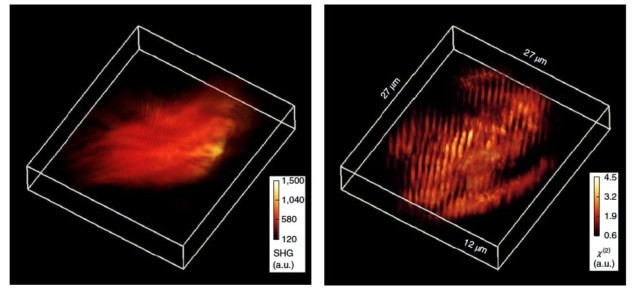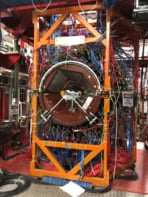
A collaborative team from Colorado State University and University of Illinois at Urbana-Champaign has developed a new type of nonlinear microscopy, called harmonic optical tomography (HOT), that can produce 3D images of biological tissues in minutes.
Nonlinear microscopy techniques have several benefits over traditional microscopy, as they can image deeper into a sample and are able to visualize many biological features without dyes or markers. One variety of nonlinear microscopy – second-harmonic generation microscopy – is particularly good at imaging molecules that are organized into filaments, such as collagen or muscle fibres.
The team, which specializes in producing holographic images of biological samples, combined this expertise with second-harmonic generation microscopy to produce the HOT microscope.
Making a microscope
The researchers began by developing theoretical models describing how to image the sample. While creating these models, they found that using out-of-focus laser light would actually provide a unique capability for 3D imaging.
They then constructed a microscope that could use these models to image samples. Crucial for development of this microscope was a custom-built high-power laser, which was then integrated into a custom holographic microscope. To achieve the specific illumination conditions to form the required second-harmonic generation signal, the researchers used unfocused light. This also allowed a larger field of the sample to be illuminated at any one time.
The team tested the microscope on myosin fibres in skeletal muscle samples. The wide-field second-harmonic generation microscopy alone was insufficient to produce high-quality data, as the images were corrupted by out-of-focus light and appeared blurry. The HOT microscope, however, uses computational algorithms to reconstruct the image to remove the stray light and produced clear artefact-free images. The HOT reconstruction revealed the distinctive fibre structure of the myosin.
Quicker and better images
Typically, producing these types of 3D images requires a laser scanning technique that sweeps through a sample pixel-by-pixel to produce a 2D image. These images are then stacked up to produce a 3D image. The HOT microscope still collects 2D images but is not restricted to pixel-by-pixel scanning. This means that HOT is considerably faster than traditional methods. As well as saving time, this makes the technique less vulnerable to unwanted vibrations and natural drift of microscope focus.
This type of microscopy can be used to image a variety of biological features and is sensitive to orientation of fibres within the sample. This could be particularly useful to image collagen in tumours, for example, where the orientation of the fibres can indicate disease prognosis. “Most investigators look at it in 2D and not 3D,” says senior author Gabriel Popescu. “Using this technique, we can use the orientation of the collagen fibres as a reporter of how aggressive the cancer is.”
This work is describe in Nature Photonics.



